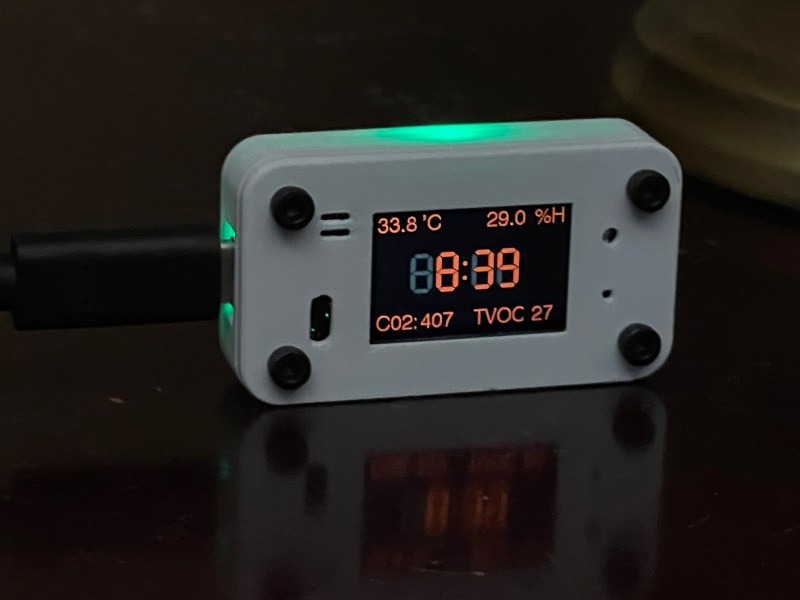It’s fall in the northern hemisphere, so [Mike Rankin]’s kids are back in school and have returned to consulting him every morning about the weather and what they should wear. Since he’s no meteorologist, [Mike] built a beautifully dim and diminutive clock that does all the work for him, plus much more. It glows a lovely dark orange that’s perfect for the nightstand and those early morning interrogations.
In default mode, this clock displays the time, CO2 level, room temperature, and humidity in that eye-friendly orange. But wave your hand in front of the time of flight sensor, and it goes external, displaying the low and high temperatures for the day, plus the weather conditions forecast. After a few seconds of that, it goes back to default mode. The ESP fetches the time from an NTP server, then gets the weather from the OpenWeather API. The indoor weather comes from a combination sensor on the board.
 Inside this tiny package is a beautifully-spun board with an ESP32 Pico D4 for a brain. In addition to the climate sensors there is a combination CO2/TVOC sensor (that’s total volatile organic compounds) to sniff out danger. There is also a pair of push buttons on the back and an ambient light sensor, but [Mike] isn’t using those just yet. Add in the Qwiic connector for future doo-dads, and you have quite the little gadget. Although the pictures make it look kind of big, you can see exactly how small it is in the demo video after the break.
Inside this tiny package is a beautifully-spun board with an ESP32 Pico D4 for a brain. In addition to the climate sensors there is a combination CO2/TVOC sensor (that’s total volatile organic compounds) to sniff out danger. There is also a pair of push buttons on the back and an ambient light sensor, but [Mike] isn’t using those just yet. Add in the Qwiic connector for future doo-dads, and you have quite the little gadget. Although the pictures make it look kind of big, you can see exactly how small it is in the demo video after the break.
[Mike] seems to like things tiny, and we admire that in a big way. Check out his positively Lilliputian ESP32 dev board.















Thank you for the wonderful write up and it is an honor to see the project on Hackaday. I rarely write code so I basically mashed together bits and pieces of a few different sketches so I’m surprised that it even works at all. For the hardware I added as many parts that I thought could come in handy with no real direction of how it would turn out. The two momentary pushbuttons and ambient light sensor work but are not used yet. The beauty is that you could change the software and use this hardware to make something completely different.
Mike
Awesome compact make, these sort are one of my fav type projects great work
Wow, terrific looking project!
And I’m guessing you built it because there isn’t a single decent bedside clock on the market today. Everything I’ve looked at lately is too bright, or too blue, or has terrible controls for setting time and alarms, or fails in any number of ways.
So congratulations on making one that fits your needs!
You are correct. Plus I had leftover parts from another project and thought it could be a good idea if it worked.
Wish it would be possible to buy this
Agreed. Had a small stash of components so I put whatever I had on hand. Only this one board has ever been assembled and I hope to put more together when the part shortage is a thing of the past.
Love the project Mike! I just happened to be designing up a PCB using the ESP32-Pico (controller for the X27.168 stepper motor: https://forum.swmakers.org/viewtopic.php?f=9&t=2477). I noticed your using the AN9520 chip antenna, How do you find your WiFi range on your clock? Are you happy with the AN9520?
Went with that antenna because of the small size but have never done any long range or performance testing. With the router in the basement and my clock upstairs in the far corner of the house, things work fine. Adding an rssi value on the screen would be a good idea in the future.
Just for other people interested in the AN9520 chip antenna, I got 23m through 5 brick walls (and internal cables etc). I was very impressed as it doesn’t take up much PCB space.